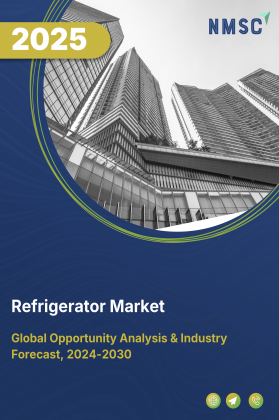
Heat Pump Market by Product Type (Air Source, Ground Source, Water Source, and Hybrid), by Capacity (Up to 10 KW, 10-20 KW, 20-30 KW, and Above 30 KW), and by End User (Hospitality, Retail, Education, Food & Beverage, Paper & Pulp, Chemicals & Petrochemicals, and Others) – Global Opportunity Analysis and Industry Forecast 2024-2030
Market Definition
The Heat Pump Market size was valued at USD 68.01 billion in 2023 and is predicted to reach USD 132.55 billion by 2030 with a CAGR of 10.3% from 2024 to 2030. Heat pump refers to a device that transfers heat from a colder area to a warmer area by using mechanical energy. Unlike its name, heat pump offers both heating and cooling capabilities that adapt to the requirements of the environment. In heating mode, it extracts warmth from external sources such as air, ground, or water, directing it indoors. In cooling mode, it removes heat from indoor air and releases it outdoors. The advantage of heat pump lies in its capacity to provide both heating and cooling functions. The versatile functioning of heat pumps not only ensures comfortable indoor environments but also helps reduce energy consumption and greenhouse gas emissions that makes heat pumps a more sustainable choice for residential and commercial heating and cooling needs.
Market Dynamics and Trends
The growing HVAC system demand accelerates the growth of heat pump market. The surge in demand of HVAC system by household and commercial place correspondently rise the demand of heat pump as it fulfils the need for efficient heating and cooling in diverse HVAC applications. According to International Energy Agency Report, 2023, 2 billion air conditioners are operating in the market in that residential units accounts for 70% of the operation. As consumers seek versatile solutions for temperature control it accelerates the demand of heat pumps that offer both heating and cooling capabilities.
Also, the rising demand of frozen is accelerating the demand of heat pump to maintain precise temperature. Heat pumps are used in refrigerated trucks and containers to transport frozen food products from manufacturing facilities to distribution centers and retail outlets. According to International Institute of Refrigeration Report, 2022, the global frozen food market generated a revenue of around USD 392.4 in 2022 billion and is expected to USD 612.3 billion by 2032. Heat pump help maintain consistent temperatures throughout the transportation process, ensuring that frozen foods remain frozen and safe for consumption that accelerates its demand in the market.
Moreover, stringent government regulation towards adoption of renewable energy is accelerating the demand of heat pump market. Setting of renewable energy targets by government as part of their broader climate and energy policies necessities the adoption of heat pumps that are capable to utilize renewable energy sources for heating and cooling purpose. In December 2023, Global Pledge on Renewables and Energy Efficiency was adopted by European Commission accompanied by over 100 world leaders to triple the global installed capacity of renewable energy sources to around 11 TW by 2030. Government-initiated renewable energy targets that accelerates the demand of heat pump that warms and expels heat using solar, wind and hydra energy.
However, regular maintenance such as filter cleaning, refrigerant level checks, and inspection of outdoor units for debris accumulation is necessary for heat pumps to maintain optimal performance and longevity results in increasing operational cost that acts as restraining factor in the growth of heat pump market. On the contrary, the integration of smart thermostats and remote monitoring in heat pump to enhance control and energy optimization is expected to boost up the demand for heat pump in the upcoming years.
Market Segmentation and Scope of the Study
The heat pump market is segmented on the basis of product type, capacity, end user, and region. On the basis of product type, the market is classified into air source, ground source, water source, and hybrid. On the basis of capacity, the market is divided into Up to 10 KW, 10-20 KW, 20-30 KW, and Above 30 KW. On the basis of end user, the market is segmented into hospitality, retail, education, food & beverage, paper & pulp, chemicals & petrochemicals, and others. Regional breakdown and deep analysis of each segment are included for North America, Europe, Asia-Pacific, and Rest of the World.
Geographical Analysis
Asia-Pacific holds the dominant share of global heat pump market and is expected to continue dominating the market during the forecasted period. This is due to the growing climate change issue contributed by rising greenhouse gas emission in the countries such as India and China accelerating the adoption of heat pumps. Climate change led to an increase in the frequency and severity of heatwaves and cold snaps in the area, consequently driving up the demand for heat pumps as it provide flexible heating and cooling solutions. According to the report of World Bank, 2022, China is the leading emitter of greenhouse gas emission that accounting for around 27 percent of global carbon dioxide emission that resulted in extreme climate change in the region. Growing climate change issue in the region is propelling the demand of heat that can handle extreme temperatures and enhance climate resilience.
Moreover, presence of stringent government regulation towards adoption of renewable energy in the region is driving the demand of heat pump. Regulations promoting renewable energy raise awareness about the environmental benefits of using clean energy sources that encourage the adoption of heat pumps as a greener alternative to traditional heating and cooling systems. In January, 2023, Indian government issued its first sovereign green bonds to expand renewable energy production and reduce carbon intensity through supporting expenditures of renewable energy. Such governmental regulations aimed at increasing renewable energy adoption drive demand of heat pumps as they utilize renewable energy sources for heating and cooling.
On the other hand, North America is expected to show a steady rise in the heat pump market. This is due to presence of large chemical industry in the region that necessities the adoption of heat pumps to maintain desired temperatures for chemical reactions, distillation, and other industrial processes. According to Cybersecurity and Infrastructure Security Agency Report of 2022, U.S. chemical industry generates USD 486 billion and contributes to around 25% to the national GDP. The significant growth of the chemical industry in the region propels the demand of heat pump to maintain precise temperature control in chemical manufacturing processes.
Moreover, the rising export of processed food in the region is further accelerating the demand of heat pump. Export of processed food requires cold chain management during transportation and distribution of food that necessities the adoption of heat pump in the region to provide consistent and controlled cooling to prevent thawing and spoilage during transit. According to Government of Canada Report, 2023, export of processed food & beverage is rising in Canada that accounts for around USD 54.3 billion in 2022 that is an increase of 14.1% from the previous year’s record. The surge in export of processed food in the region propels the demand of heat pump that includes precise temperature control capabilities to ensure that products remain at the required temperatures throughout the supply chain and preserve their quality and safety during transit.
Competitive Landscape
The heat pump market comprises of various market players such as Mitsubishi Electric Corporation, Panasonic Corporation, Daikin Industries, Ltd., Hitachi, Ltd., Robert Bosch GmbH, Johnson Controls Inc., Danfoss Group, Lennox International Inc., Carrier Global Corporation, LG Electronics, Inc., Samsung Electronics, A.O. Smith Corporation, Thermax Limited, V-Guard Industries Ltd., Havells India Ltd.. These companies are adopting various strategies such as product launch and acquisition to remain dominant in the heat pump market.
For instance, in January, 2024, Bosch launched cold climate heat pump for residential applications that addressed the need for efficient heating solutions in colder climates. This product launch expanded the offerings in the heat pump market and provided homeowners with reliable and energy-efficient options for maintaining indoor comfort even in extreme weather conditions.
Further, in November, 2023, Daikin's launched VRV5 heat pumps feature that enhanced energy efficiency and performance and catered to the increasing demand for sustainable heating and cooling solutions. This product launch demonstrated Daikin's commitment to technological advancement in the heat pump market by providing customers with reliable and eco-friendly heat pump solutions for residential and commercial buildings.
Moreover, in January, 2023, Johnson Controls acquired Hybrid Energy to enhance its industrial heat pump portfolio and strengthened its position in the heat pump market. This acquisition enabled Johnson Controls to offer a wider range of efficient and sustainable heating solutions for industrial applications and meeting the growing demand for energy-efficient technologies in various sectors.
KEY BENEFITS
-
The report provides quantitative analysis and estimations of the heat pump market from 2024 to 2030, which assists in identifying the prevailing market opportunities.
-
The study comprises a deep dive analysis of the heat pump market including the current and future trends to depict prevalent investment pockets in the market.
-
Information related to key drivers, restraints, and opportunities and their impact on the heat pump market is provided in the report.
-
Competitive analysis of the players, along with their market share is provided in the report.
-
SWOT analysis and Porters Five Forces model is elaborated in the study.
-
Value chain analysis in the market study provides a clear picture of roles of stakeholders.
KEY MARKET SEGMENTS
By Product Type
-
Air Source
-
Ground Source
-
Water Source
-
Hybrid
By Capacity
-
Up to 10 KW
-
10-20 KW, 20-30 KW
-
Above 30 KW
By End User
-
Hospitality
-
Retail
-
Education
-
Food & Beverage
-
Paper & Pulp
-
Chemicals & Petrochemicals
-
Others
By Region
-
North America
-
The U.S.
-
Canada
-
Mexico
-
-
Europe
-
The U.K.
-
Germany
-
France
-
Italy
-
Spain
-
Denmark
-
Netherlands
-
Finland
-
Sweden
-
Norway
-
Russia
-
Rest of Europe
-
-
Asia-Pacific
-
China
-
Japan
-
India
-
South Korea
-
Australia
-
Indonesia
-
Singapore
-
Taiwan
-
Thailand
-
Rest of Asia-Pacific
-
-
Rest of the World (RoW)
-
Latin America
-
Middle East
-
Africa
-
REPORT SCOPE AND SEGMENTATION:
|
Parameters |
Details |
|
Market Size in 2023 |
USD 68.01 Billion |
|
Revenue Forecast in 2030 |
USD 132.55 Billion |
|
Growth Rate |
CAGR of 10.3% from 2024 to 2030 |
|
Analysis Period |
2023–2030 |
|
Base Year Considered |
2023 |
|
Forecast Period |
2024–2030 |
|
Market Size Estimation |
Billion (USD) |
|
Growth Factors |
|
|
Countries Covered |
28 |
|
Companies Profiled |
15 |
|
Market Share |
Available for 10 companies |
|
Customization Scope |
Free customization (equivalent up to 80 working hours of analysts) after purchase. Addition or alteration to country, regional, and segment scope. |
|
Pricing and Purchase Options |
Avail customized purchase options to meet your exact research needs. |
KEY MARKET PLAYERS
-
Mitsubishi Electric Corporation
-
Panasonic Corporation
-
Daikin Industries, Ltd.
-
Hitachi, Ltd.
-
Robert Bosch GmbH
-
Johnson Controls Inc.
-
Danfoss Group
-
Lennox International Inc.
-
Carrier Global Corporation
-
LG Electronics, Inc.
-
Samsung Electronics
-
A.O. Smith Corporation
-
Thermax Limited
-
V-Guard Industries Ltd.
-
Havells India Ltd.




















 Speak to Our Analyst
Speak to Our Analyst

























